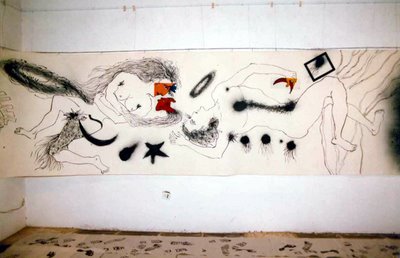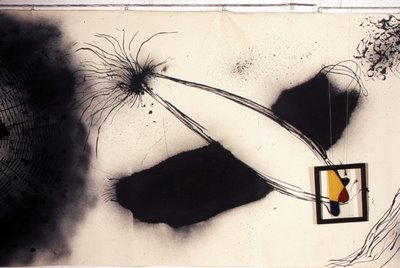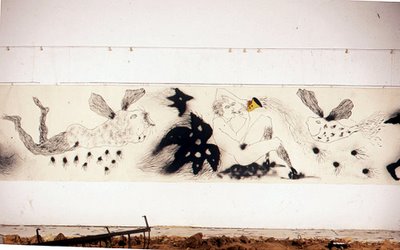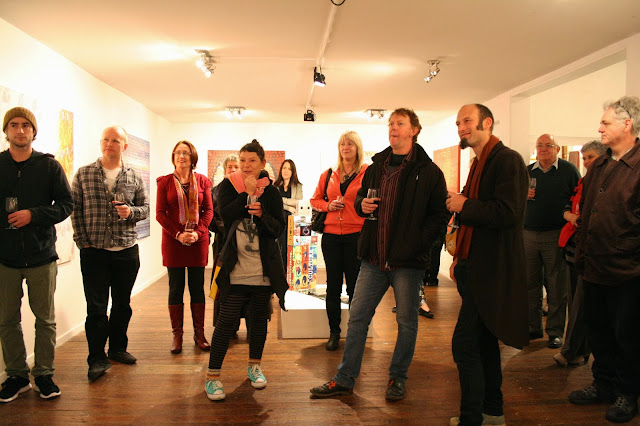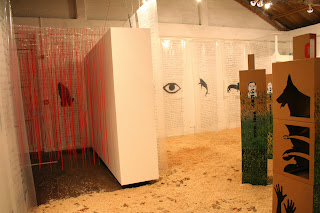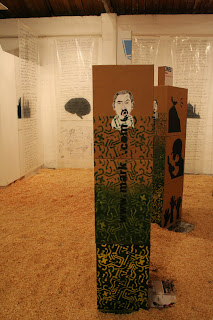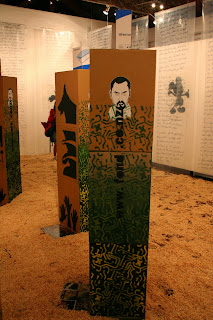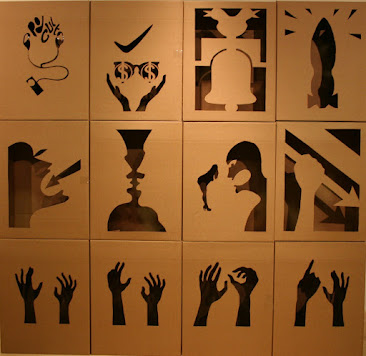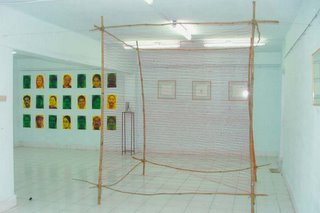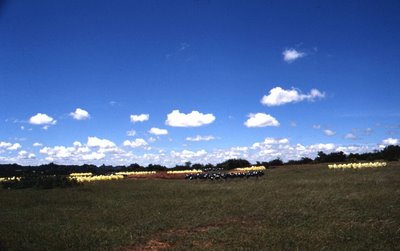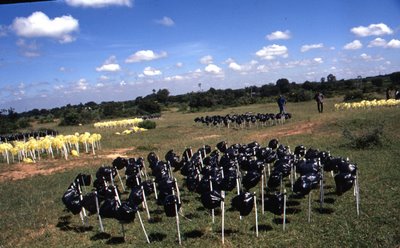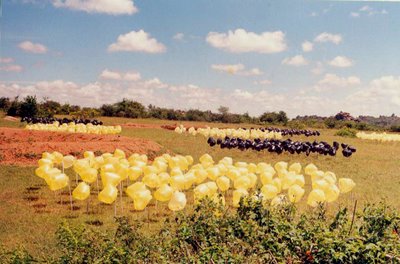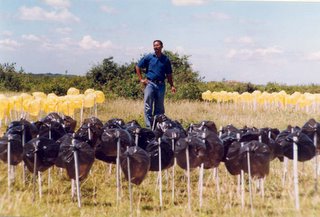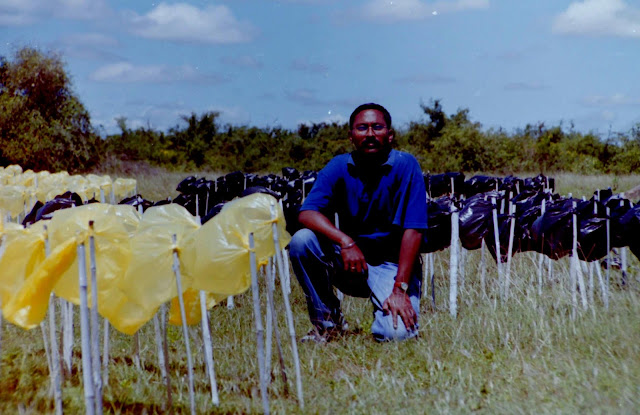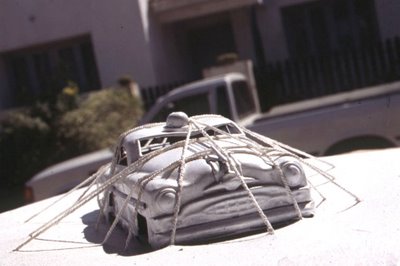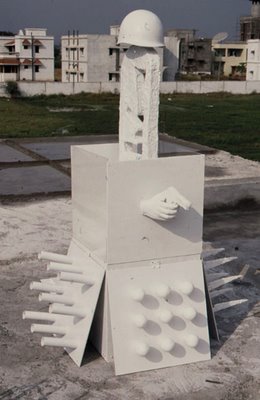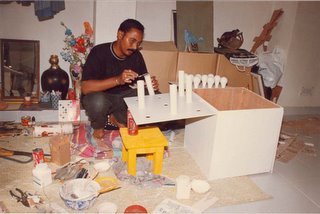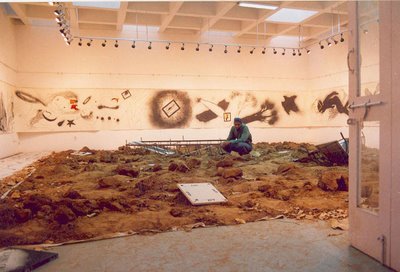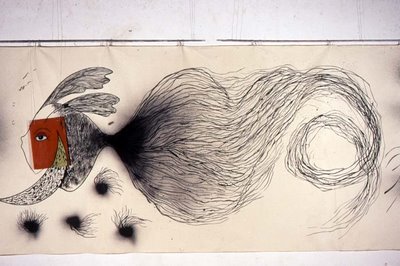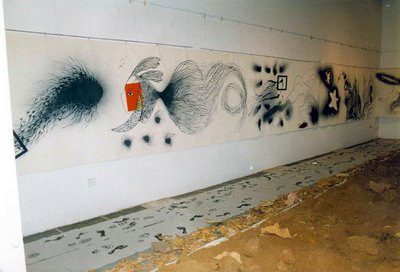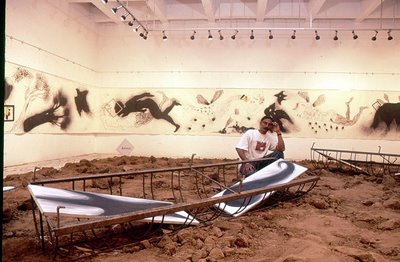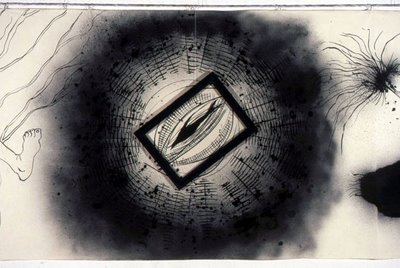Duppati Installations since 1996
PROJECT EULOGY
EULOGY TO THE INFINITE SOUL
TE WHARE TAONGA O WAIKATO MUSEUM & GALLERY, HAMILTON, NZ
2025
These still boats are objects of such acts of veneration that operate and signify those marks made on a lifescape sometimes following the beacon of light while some are caught up in an unending circle of an unknown void.
My work delves into the profound relationship between life, death, and memory, presenting the idea that death marks not an end but a transformative threshold into a new form of existence. At the core of this exploration is the concept that memories, as collective reflections intertwined with personal experiences, serve to immortalise the essence of life beyond our human perceptions.
The journey begins with the contemplation of life itself, where one inevitably confronts the spectre of death. Death, however, is not seen merely as a cessation but as a profound transition—a metamorphosis that sustains the vitality of those who have passed on through the persistence of memory and experience. This notion that death signifies a continuation rather than an end forms the central theme of my work.
To express this concept, I employ the metaphor of boats navigating the streams of memory. These vessels embody moments of joy and poignant connections with departed souls, symbolising the paths paved by nature's bliss and the enduring presence of loved ones. My childhood memories of crafting paper boats and setting them adrift on rainy days play a significant role in this symbolism, evoking the ephemeral act of creation and the joy it brought.
As the work develops, the metaphor of boats evolves to include a coffin carved into each vessel, a poignant symbol of life's journey and the lasting impact of those who have departed. These boats, carrying the essence of cherished souls, navigate the currents of memory, illustrating the profound continuity of life beyond death.
Central to this exploration is the recognition of the profound impact that relationships and attachments forged in life have on us. These bonds, though vulnerable to the pain of loss, leave lasting impressions that shape both our individual and collective identities. The scars left by loss, whether visible or hidden, become part of the complex tapestry of memory, informing our understanding of existence as something that transcends the ephemeral and transforms our consciousness into a collective identity.
Ultimately, my work seeks to demonstrate how death initiates a transformation where memories and experiences become the enduring legacy of existence. Through the exploration of these themes, the installation invites a deeper contemplation of how we perceive and commemorate life, death, and the interplay of memory in shaping the human experience. The stories and songs that emerge from these narratives celebrate the richness of existence, reflecting the immutable truth of life's continuity beyond death.
Sudhir Duppati
‘ERASED’ (2013)
Refinery Artist Space, Nelson, NZ
Goldanizing- A Collaborative Mark Making Series (2013)
Location: Wellington Stamping Site, Milfort Flats, NZ
Human greed for gold has led to a relentless pursuit that transcended boundaries, resulting in colonization. This precious metal became a driving force for invasions and political dominance, often at the expense of human lives and values. Entire cultures fell victim to this insatiable desire, serving as collateral in the pursuit of wealth. This dark chapter in history underscores how materialism can erode the bonds that should unite humanity, perpetuating a cycle of exploitation and division.
De-Mark, Faculty of Fine Arts Gallery,
MS University, Baroda, India (2009)
When I Met My Soul (2007) "Embodied Paradox: An Exploration of Human Existence"
"In 'When I Met My Soul,' I embark on a journey into the intricate tapestry of human experience, juxtaposing vivid visuals from the material and spiritual realms. Through this immersive exploration, I seek to evoke an immediate and profound understanding of the dualities that shape our existence.
This endeavor is not only a personal odyssey through the inherent contradictions within human life, but also a call to demystify these complexities within our society. It emphasizes the imperative need for heightened awareness regarding the far-reaching consequences of our actions. In contemplating the existential dualities that define all aspects of life, a deeper purpose of existence emerges.
This state of self-awareness, often referred to as higher consciousness or meta-consciousness (as articulated by Jonathan Schooler), holds the potential to catalyze spiritual growth. The central space within this installation invites visitors to meditate and reflect upon the essence, presence, and absence of the human soul.
Simultaneously, it prompts a moment of pause to scrutinize inhumane actions, compelling us not only to think but also to act. By revisiting the fundamental tenets of our lives—'Live and let live'—we nurture hope for a sustainable future.
My immersion in various cultures while working and honing my craft in both national and international art institutes has endowed me with a profound understanding of diverse human conditions. Religion, science, and the spiritual realm have been focal points of my exploration in the quest for ultimate truth. It is a truth that holds the power to emancipate life's resources and liberate the soul from its entanglement with the relentless material manifestations.
This body of work was conceived during my artist residency at the Wesley Seminary Henry Luke III Centre for Art and Theology in Washington DC. Subsequently, it found a home at the Tamarind Art Museum in New York. The meticulous process involved the use of approximately 20 craft blades/knives to intricately inscribe 160 boxes. I set a personal challenge to design and draw at least 10 boxes daily, ultimately dedicating around 20 days to this endeavor. The delicate interplay of 3200 threads was accomplished in a single day, thanks to the invaluable assistance of Rosanne, Rupa, Rekha, Brandon, and Eldina. The plaster cast serves as a profound impression of Allison's (an American University Post Grad Student in Painting) hand, who generously volunteered her time for four hours, allowing me to capture this mold. To each and every one of you, my deepest gratitude.
Material used:
woolen Yarn: 300mt X 40 rolls Approximately 3200 hangings
Carton Boxes: 156 each measuring 31" X 24" X 13"
One Female hand Plaster Cast
Area of the Exhibit 232" X 240"
Maps Metaphors and Mythology (2007)
Tamrind Art Museum, New York
The work titled "we-us-our," presented here, is a result of group participation in an exhibition titled "Maps, Metaphors, and Mythologies" at Tamarind Art, NY, curated by Dr. Deepanjana Klien Danda. This work is a part of my research practice that explores various aspects of "marks" and their creation, identification, association, interpretation, understanding, and analysis. "we-us-our" delves into the current human conditions affecting our existence, not to determine the 'WHO,' but to address the insecurities and dilemmas prevalent in contemporary societies worldwide. It reflects our shared desire to live in a favorable environment and atmosphere.
The exhibition primarily draws inspiration from Michael Foucault's lecture, "Of Other Spaces," in which he observes, "We are in the epoch of simultaneity; we are in the epoch of juxtaposition, the epoch of near and far, of the side-by-side, of the dispersed. We are at a moment, I believe when our experience of the world is less like that of a long life developing through time and more like a network connecting points and intersecting with its own skein."[1]
Human connectivity exists through various means and modes. While each of us is an individual, we are undeniably connected, whether physically (through bodies), mentally (in a transcendental sense), metaphysically (in our minds), virtually (in perception), or even through the imaginative powers of fantasy and manifestation. At times, we may feel detached from what is happening around us. The sense of association, the question of being a part of something or someone, and the essence of "being" itself hold profound implications in the phenomenology[2] of life. The consequences of our actions and their effects are intertwined with our (sub)conscious minds. Life's directed forces and energies can diverge, whether naturally or to fulfill selfish or selfless desires of human beings. Within these parameters of existence, vested human interests like violence, war, environmental degradation, power politics, and other inhumane activities have led to unpredictable catastrophes, endangering and even pushing our species toward extinction.
The concept of imperfection as an accepted human quality has influenced and, in some cases, hindered the pursuit of perfection. Perfection is often viewed as unattainable, but this hasn't deterred the attempts of a select few enlightened individuals. It is sometimes misunderstood as the ultimate supernatural reality or myth, reduced to a human construct where life cannot exist without intended sacrifices. My aim is to demystify this contradiction in our society and emphasize the importance of greater awareness regarding the consequences and contributions of our actions. Therefore, I use elements from popular culture and representations thereof as a focal point of interest. My experience of various cultures from an Eastern perspective has enabled me to contemplate existing human conditions and the possibilities for spiritual growth.
[1] "Of Other Spaces," Michael Foucault, 1967, Heterotopias Lecture, published by the French journal Architecture/Mouvement/Continuite in 1984. [2] Edmund Husserl's and Martin Heidegger's contrasting theories of phenomenology, which include Realistic Phenomenology, Constitutive Phenomenology, Existential Phenomenology, and Hermeneutical Phenomenology, each focusing on different aspects of human existence and consciousness.
Realistic Phenomenology- search for the universal essence of various sorts of matters, including human actions, motives, and selves. Adolf Reinach adds philosophy of law, Max Scheler added ethics, value theory, religion, and philosophical anthropology; edith stein added philosophy of the human sciences. Alexander Pfander, Herbert Spiegelberg and Karl Schuhmann and Barry Smith –successive leaders of this tendency.
Constitutive Phenomenology- 1913 by Husserl, philosophy of the natural sciences. Oskar Becker, Aron Gurwitsch and Elisabeth Stroker- transidental phenomenological epoche and reduction. This procedure involves suspending acceptance of the pregiven status of conscious life as something that exists in the world and is performed in order to secure an ultimate intersubjective grounding for the world and the positive sciences of it. Use of this method places constitutive phenomenology in the modern tradition that goes back at least to Kant, and also characterizes the rest of Husserl's work.
Existential phenomenology- Martin Heidegger's Sein und Zeit of 1927, use an analysis of human being as a means to a fundamental ontology that went beyond the regional ontologies described by Husserl.
Concerned topics of this ideology are - action, conflict, desire, finitude, oppression, and death. Arendt contributed to political theory and the problematics of ethnicity, Beauvoir raised the issue of gender and old age, Merleau-Ponty creatively continued the appropriation of Gestalt psychology in his descriptions of perception and the lived body, and Sartre focused on freedom and literature. Recent philosophers are - John Compton, Michel Henry, Maurice Natanson, and Bernhard Waldenfels.
Hermeneutical phenomenology - Heidegger's Sein und Zeit, in which human existence is interpretative. Hans-Georg Gadamer's Platons dialektische Ethik (1931), reemerging after Germany's National-Socialist period with his Wahrheit und Methode (1960). Other leaders include Paul Ricoeur, Patrick Heelan, Don Ihde, Graeme Nicholson, Joseph J. Kockelmans, Calvin O. Schrag, Gianni Vattimo, and Carlo Sini.
Dunedin Fringe Festival 2006
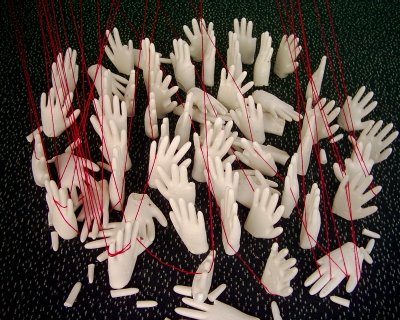


Exploring Mark Making (2004)
'Marks' Installation with Bamboo sticks and red woolen thread, 3mtrX3mtr, Daira Gallery, India, 2004.
Poly-Farming (1999)
A view of Poly Farming, Environmental Installation with 2000 polythene bags and 2000 bamboo sticks, grouped as 100 in each spiral, to mark the year 2K with the industrialization and its effects on human lives. A social statement against the use of polythene bags.

Looking from Within (1999)

'Entrance view, Gallery built with wood and canvas, Alliance Francaise De Hyderabad, 1999.
 'Status Symbol', White series, Found Toy Car Stitched on canvas, 50X50Cms, Looking From Within, 1999.
'Status Symbol', White series, Found Toy Car Stitched on canvas, 50X50Cms, Looking From Within, 1999.

ALTERED SPACE (1997)
Altered Spaces: Exploring Boundaries in Art and Space"
I invite you to embark on a journey of inquiry and discovery, where art transcends its conventional confines and breathes new life into the spaces it inhabits. This collection represents a culmination of my explorations in conceptual art, delving into fundamental questions about art and challenging established norms. Through a synthesis of diverse mediums, I seek to redefine the boundaries of artistic expression, blurring the lines between form and environment.

The conventional gallery setting is not merely a backdrop, but an integral component of the artistic experience. "Altered Spaces" ventures beyond the traditional confines of art display, embracing the concept of site-specific installations. Each piece is meticulously crafted to resonate with the unique spatial characteristics of its environment. By placing works on various levels, including pillars and floors, I aim to dissolve the boundaries between art and space, encouraging viewers to engage with their surroundings in a more immersive manner.
My show alters the Gallery Experience and seeks to challenge the conventions of gallery viewing. Through careful curation and placement, I endeavour to prompt a reevaluation of how art is encountered. The atmosphere within the created environment becomes an inseparable part of the work, adding layers of meaning and emotion. Viewers are invited not only to observe but to navigate and interact, fostering a dynamic dialogue between the artwork, the space, and the spectator.
Altered spaces is an exploration of the symbiotic relationship between art and space, where the boundaries between creator and viewer, form and environment, blur into a seamless continuum. It is an invitation to question, to experience, and to engage with art in its most dynamic and transformative form. I hope that this collection inspires you to see not only what is, but what can be, as we journey together into uncharted realms of artistic expression.
Gallery at Alliance Francaise De Hyderabad, 1997.
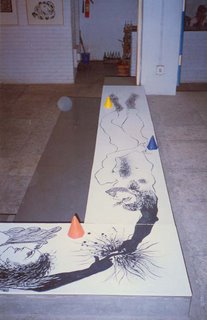

Form and Space (1997)
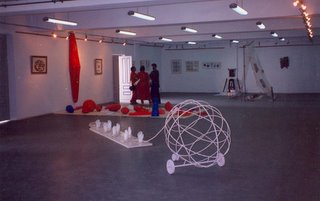



The Container (Assemblage)
In the realm of my artistic endeavors, I find solace in the amalgamation of the mundane and the abstract, where everyday occurrences and commonplace rituals intertwine with cerebral and speculative perspectives. This convergence takes shape within a multifaceted space, woven together by diverse functions, histories, social strata, and representations.
The spectrum of objects I employ, whether in their original state or aided as ready-mades, serves as the elemental building blocks of my art. These objects range from casually positioned everyday items, each laden with its own cultural significance, be it within the confines of a society dominated by industry and consumerism, or intimately connected to the personal narrative of an individual, rooted in natural forms rather than mass-produced goods.
Within this framework, my creative processes are ignited by the dynamics of industrialization, technology, consumerist tendencies, violence, innovations, and defense strategies. The inclusion of ready-made objects alongside plaster casts of my own hands infuses a deeply personal touch, encapsulating a moment suspended in time within the artwork itself. Enveloped in a glistening white aura, which plays with shadows, these applied objects gain a newfound vision and dimension, redefining their essence. This temporal freeze finds resonance in the context of India's 50 years of independence, prompting us to contemplate our very existence.
In contemplating the cultural tapestry of human existence, this dialectical interplay of contexts finds expression through experimental definitions. It may not necessarily beckon the immutable truth, but it undeniably stands as a beacon of signifying truth, one that imparts meaning—sometimes, even on a universal scale.
This reflection on the amalgamation of the quotidian and the abstract, the personal and the societal, invites viewers to embark on a journey of introspection, prompting them to reevaluate their own existence and the layers of meaning that permeate it. In doing so, we unearth the profound significance hidden within the seemingly trivial, and perhaps stumble upon a truth that resonates across borders and cultures.
Duppati Sudhir Kumar, 1997, Jagruti show, Lakheeren Art Galley, Mumbai.
My Minds Wank (1996)
Exploring Paradoxical Art: Breaking Boundaries in Gallery Space Manipulation
In the enigmatic realm of paradoxical art practices, I uncover yet another facet of artistic expression, delicately woven within the confines of established gallery spaces.
My exhibition seeks to distill complexity into simplicity, offering an ironic self-awareness of the artist amid a subtly nuanced context. It's a deliberate attempt to challenge conventions and provoke introspection.
Throughout the annals of history, humanity has fervently pursued the 'new'. This elusive novelty promises a fresh lens through which to perceive the world—framed and unframed, articulated and inferred, observed and envisioned. Art, too, has been a faithful companion on this quest, tirelessly seeking new paths in the visual landscape, striving for a liberation of intricacies.
The manipulation of gallery space is an art form in itself, and it serves as the canvas for my belief in the untapped potential of uncharted avenues. Within this transformative space, the gallery transcends its indoor confines, becoming a symbolic act of redefining authority. The once bare floor is reborn as an outdoor landscape, inviting viewers to reimagine their surroundings. This metamorphosis blurs the customary boundaries between painting and sculpture, transforming the gallery into a holistic three-dimensional experience. To be accepted within this space is an acknowledgment of artistic freedom granted by the authority. My canvas, stretching panoramically across the gallery wall at eye level, offers a unique perspective that diverges from the half manipulated on the floor. This continuity beyond a single glance beckons the viewer to step into my imaginative world. The viewer's gaze becomes a window to the immediate environment, onto which a new vision is projected. Thus, the images on the canvas, in tandem with the extended space beyond, form a representation of the tangible world in which the observer is immersed. This dynamic challenges the notion of confinement within the gallery, as it is perceived from the outside. The single-piece canvas, spanning 140 feet by 5 feet, focuses on my envisioned world, complemented by colored visuals on glass, which present conventionally framed works in an unconventional display.
The human experience is often depicted as a horizontal plane, both mentally and physically. I seek to disrupt this notion, inducing a mental disjunction in the viewer, while the textured floor invites the touch of a bare foot, intended to create a sensory connection.
The genesis of being—the potentiality of existence—is brought to life through painted forms, depicted in stark black on white, representing the void, the nothingness of the observable. Much like the forces and energy activated by vacuum, beyond mortal comprehension, these organic elements of nothingness, whether mythical or real, find a place in my imaginative realm. It exists beyond the realm of genesis, a realm where imagination persists, defying rationality. My work contemplates the ordinary and the extraordinary.
Is it a profound contemplation of experience or introspection? Is it selfless inquiry or a manifestation of hubris? In artists and writers of experience, does imagination illuminate the real world or does it submit in servitude?
My thoughts and creations, constantly evolving, traverse a landscape of wonder and discovery, exploring remarkable vistas. This dynamic rarely allows me to dwell on conventional musings. Instead, it encourages me to plumb the depths of ideas that span from the mysterious reaches of boundless abundance to the tangible world, crafted by both nature and human hands.
My works, displayed here, are a testament to my ongoing exploration of this enigmatic world, an endeavor to immerse myself in the inexhaustible depths of life's captivating essence, guided by ever-evolving ideas and conventions.
To me, the ability to present any visual expression and deem it art embodies the essence of presentability, transcending subjectivity and encapsulated content. This, for me, is the true essence of innovation. Departing from the conventional practices of art—whether confined to easel painting or hesitant to explore diverse mediums—requires a thorough reevaluation of their formal structure. Only when such endeavors are appreciated can we transcend these conceptual boundaries. In this sense, the adventure of thought remains incomplete without a corresponding adventure in language and presentation.
In essence, the constituent elements of my artwork serve a diverse array of systematic functions, coalescing to craft images that I identify as representational, yet suffused with a pulsating vitality, radiating a vision. Their purpose is to imbue the image with an inner life that reverberates through the air and space surrounding it.
When confronted with a work of art, one's reaction may range from indifference to aversion, akin to encountering a stranger. Whether it be painting, sculpture, music, poetry, or drama, it can strike a responsive chord within us, evoking an emotional impression and potentially stimulating the mind. Regardless of our reaction, we experience the effect, yet remain unaware of its origin. This differs from other life experiences, such as intuition, impulses, premonitions, visions, spontaneous insights, sudden recollections, and moments of forgetfulness (amnesia). Often, we overlook these perceptions, engrossed in our daily routines. They strike me as greetings from an unknown sphere or a form of communication between our subconscious and conscious selves. On this plane of sensibility, art impacts us as an inner experience, an intuitive knowledge rather than a logical one.
March 1996, Faculty of Fine Arts Gallery, M S University, Baroda.
